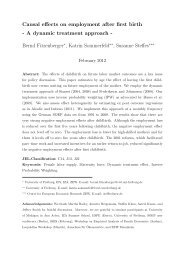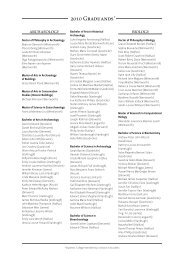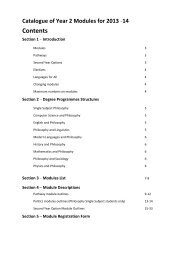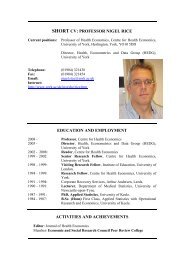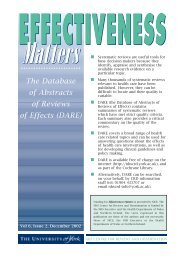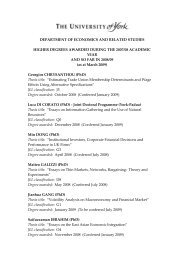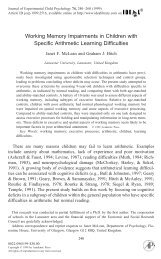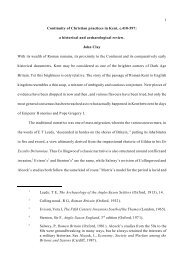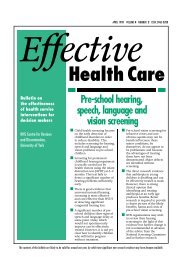GeloriniPhD (PDF , 6973kb) - University of York
GeloriniPhD (PDF , 6973kb) - University of York
GeloriniPhD (PDF , 6973kb) - University of York
You also want an ePaper? Increase the reach of your titles
YUMPU automatically turns print PDFs into web optimized ePapers that Google loves.
. 41 .<br />
CHAPTER 1<br />
Diversity and ecology <strong>of</strong> tropical African fungal spores<br />
Diversity and ecology <strong>of</strong> tropical African fungal spores from a 25,000-year<br />
palaeoenvironmental record in southeastern Kenya<br />
Modified from van Geel, B., Gelorini, V., Lyaruu, A., Aptroot, A., Rucina, S., Marchant, R., Sinninghe Damsté, J.S., Verschuren, D.,<br />
2011. Review <strong>of</strong> Palaeobotany and Palynology 164, 174-190.<br />
Abstract<br />
Fossil fungal spores and other non-pollen palynomorphs (NPPs) are powerful environmental proxies in European<br />
palaeoecological and archaeological contexts. However, their application on other continents, and particularly in the<br />
tropics, is hampered by uncertain equivalence with morphologically similar taxa in Europe, and incomplete knowledge<br />
<strong>of</strong> their ecology in the new local contexts. Here we use fossil NPP assemblages in a 25,000 year sediment record from<br />
Lake Challa, a steep-sided crater lake near Mt. Kilimanjaro in southeastern Kenya, to assess NPP diversity in a tropical-<br />
African context and the equivalence <strong>of</strong> African taxa with their European counterparts. We recovered a total <strong>of</strong> 65 welldefined<br />
NPP types, <strong>of</strong> which 61 are fungal spores, and 42 could be linked to known taxa. We provide diagnoses and<br />
illustrations <strong>of</strong> 61 recovered taxa, 58 <strong>of</strong> which have not been documented before.<br />
Using the Challa pollen record <strong>of</strong> past regional vegetation dynamics and two independent proxies <strong>of</strong> past<br />
temperature and rainfall, we also assessed the association <strong>of</strong> individual fungal taxa with particular species and biomes<br />
<strong>of</strong> tropical-African vegetation, and with the history <strong>of</strong> regional climate change. We <strong>of</strong>ten found strong correspondence<br />
between the stratigraphic distribution <strong>of</strong> individual fungal spore taxa and the occurrence <strong>of</strong> specific vegetation types.<br />
Changing climate conditions appear to have had a strong impact on the ability <strong>of</strong> fungi to play a role in the decomposition<br />
<strong>of</strong> dead plants. For fungal spore assemblages, the most prominent change in regional palaeoenvironments over the past<br />
25,000 years occurred at the start <strong>of</strong> the wet early Holocene, following Younger Dryas drought. Epicoccum purpurascens<br />
is common in the Glacial and Late-Glacial parts <strong>of</strong> the sequence, but shows a strong decline during the early Holocene.<br />
Coniochaeta cf. ligniaria occurs throughout the record but shows dramatic fluctuations that appear to relate to major<br />
changes in humidity. Correlation between fungal abundance and humidity is also observed in taxa for which the Challa<br />
region provided suitable habitat from ca. 16,500 cal. yr BP (e.g., Curvularia) or from the Late-Glacial to Holocene transition<br />
(e.g., Tetraploa aristata, Dictyoarthrinium cf. sacchari, cf. Byssothecium, Types HdV-1032 and HdV-1033, cf. Alternaria, cf.<br />
Brachysporium, cf. Helminthosporium, Spegazzinia tessarthra and cf. Lasiodiplodia theobromae). Many <strong>of</strong> these taxa did<br />
not occur, or were rare, during both wet and dry phases <strong>of</strong> the Glacial period, suggesting an additional temperature<br />
effect on their occurrence in tropical African environments. A possibly dominant role <strong>of</strong> temperature is revealed in the<br />
stratigraphic distribution <strong>of</strong> Acrodictys, which appears at the onset <strong>of</strong> deglacial climate warming ca. 17,500 cal. yr BP<br />
and remains common throughout both wet and dry phases <strong>of</strong> the Holocene. Spores <strong>of</strong> the dung-inhabiting fungus<br />
Sporormiella occur throughout the 25,000-year record without notable fluctuations, suggesting little changes in the<br />
overall population density <strong>of</strong> large herbivores in the region.<br />
Key words: Non-pollen palynomorphs, fungal spores, Lake Challa, Kenya, Late-Glacial, Holocene.<br />
1.1. Introduction<br />
The palaeoecological potential <strong>of</strong> fungal remains is not yet fully explored. Many palynologists do not present or discuss<br />
the remains <strong>of</strong> fungi and other non-pollen palynomorphs (NPPs) that are commonly found in pollen preparations.<br />
However, palaeomycological information can be very useful, especially in studies <strong>of</strong> peat, lake and soil deposits (van



